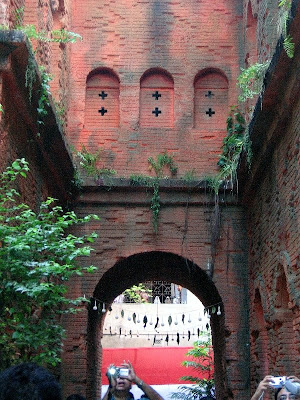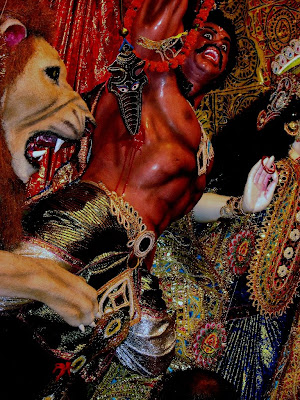 'Art of Grotesque' .... the foliages on left and right sides are dissimilar!
'Art of Grotesque' .... the foliages on left and right sides are dissimilar!
Watch out the difference in layout .... quite interesting !
From small temple at Antpur,Dt. - Hooghly.
Till I did a bit of Internet search for writing on the ‘Art of Grotesque’ in terra cotta temples of Bengal, I did not know about genesis of the word ‘Grotesque’. In art, this is a style that applies mostly to decorative frescoes where human figures, often with distortions and imaginary monsters are displayed with animals, floral patterns in a fanciful and eccentric manner which was first used at the Domus Aurea (Golden House) of Emperor Nero and the Baths of Emperor Titus. This was discovered during excavation of Roman houses during the 15th century. This type of art came to be known as ‘grotteschi’ from the word ‘grottoes’ or underground chambers.
 Courtesy : http://www.spamula.net/blog/2006/06/faces_of_the_grotesque_1.html
Courtesy : http://www.spamula.net/blog/2006/06/faces_of_the_grotesque_1.html
I visited a couple of Internet sites to view the examples on display. I found strange and uncommon ornamental delicate designs of foliage and flowers, stylised human heads and strange animals, all composed, merged and mixed to create one ‘decorative whole’. I learnt that the principal painter of the Domus Aurea,Fabullus went for a few hours of work to the ‘Golden House’ each day while the light used to be right ( Pliny in his book ‘Natural history’). Inspired by these designs, Italian Renaissance artists; Raphael and his followers adopted this style in their frescoes . We can see examples in Pinturicchio's cathedral library ceilings at Siena (1502), and Perugino's ceiling of the Cambio in Perugia (about 1500).
Later on, the artistes from the Western world used techniques like separation, mixture, reassembly, duplication, multiplication, elongation, compression, enlargement, miniaturization, reversal, simplification, overcrowding, and fantastic interpretation while creating artwork of this category.
Among the hundreds of terra cotta panels created by Bengal’s artists during 17th to 19th centuries, we find many examples which stand out as our ‘grotesque’ artwork . The battle scenes of ‘Ramayana’ are the best but not the only examples.
 Overcrowded and figures formed as "Monkey's and 'Rakhsasa's.
Overcrowded and figures formed as "Monkey's and 'Rakhsasa's.
War scene from Ramayana.
Pancha Ratna Temple : Bishnupur.
 Blow-up I from the above panel
Blow-up I from the above panel
 Blow-up II from the above panel
Blow-up II from the above panel
I post here several photographs to illustrate artwork of the grotesque in Bengal’s temples.I have started with Ramayana battle scenes which have a lot of ingredients of grotesque. They are so. Both the army of ‘monkey’s and the ‘rakshasa’s invited depiction of forms with fantastic interpretation, distortion and overcrowding. Since,Terra cotta artists have used the technique of overcrowding repeatedly, I made an endeavour to identify and present grotesque artwork of other types.In future, I would like to discover the route of the idea of 'Art of Grotesque' from Europe to India.
 A man squeezes two lions with his hands
A man squeezes two lions with his hands
while he tramples and subdues two elephants !
 An imagenry winged animal, with curved beaks, a lot of teeth,
An imagenry winged animal, with curved beaks, a lot of teeth,
tramples elephants , yet strangles another elephant with its tail!
Size of this animal will be at least five times that of an elephant ! !
The above two panels are from Jor-Bangla.
I have two submissions to make to persons who are quite familiar with the terra cotta panels of Bengal's temples. Firstly, I have not used any of the 'social' panels with exaggeration,i.e., I have not used imageries which can be termed as 'caricature'. These panels can be taken up separately in a different article. Secondly,.... and this is a very important and sensitive point too...I have not touched any of the images of Bishnu's 'Dashavatar' where He manifests Himself as half-human-half-animal Being . In the eye of an Westerner , these images may appear to match their criteria of 'Grotesque Art' , but, according to Hindu scripture , these images convey much deeper meaning.
I end with another artwork from the small temple of Antpur , an example of 'Art of grotesque'.





















